Note
Click here to download the full example code or to run this example in your browser via Binder
2D MAT data of KMg0.5O 4.SiO2 glass¶
The following example illustrates an application of the statistical learning method applied in determining the distribution of the nuclear shielding tensor parameters from a 2D magic-angle turning (MAT) spectrum. In this example, we use the 2D MAT spectrum 1 of \(\text{KMg}_{0.5}\text{O}\cdot4\text{SiO}_2\) glass.
Setup for the matplotlib figure.
import csdmpy as cp
import matplotlib.pyplot as plt
import numpy as np
from matplotlib import cm
from csdmpy import statistics as stats
from mrinversion.kernel.nmr import ShieldingPALineshape
from mrinversion.kernel.utils import x_y_to_zeta_eta
from mrinversion.linear_model import SmoothLassoCV, TSVDCompression
from mrinversion.utils import plot_3d, to_Haeberlen_grid
Setup for the matplotlib figures.
# function for plotting 2D dataset
def plot2D(csdm_object, **kwargs):
plt.figure(figsize=(4.5, 3.5))
ax = plt.subplot(projection="csdm")
ax.imshow(csdm_object, cmap="gist_ncar_r", aspect="auto", **kwargs)
ax.invert_xaxis()
ax.invert_yaxis()
plt.tight_layout()
plt.show()
Dataset setup¶
Import the dataset¶
Load the dataset. Here, we import the dataset as the CSDM data-object.
# The 2D MAT dataset in csdm format
filename = "https://zenodo.org/record/3964531/files/KMg0_5-4SiO2-MAT.csdf"
data_object = cp.load(filename)
# For inversion, we only interest ourselves with the real part of the complex dataset.
data_object = data_object.real
# We will also convert the coordinates of both dimensions from Hz to ppm.
_ = [item.to("ppm", "nmr_frequency_ratio") for item in data_object.dimensions]
Here, the variable data_object is a
CSDM
object that holds the real part of the 2D MAT dataset. The plot of the MAT dataset
is
plot2D(data_object)
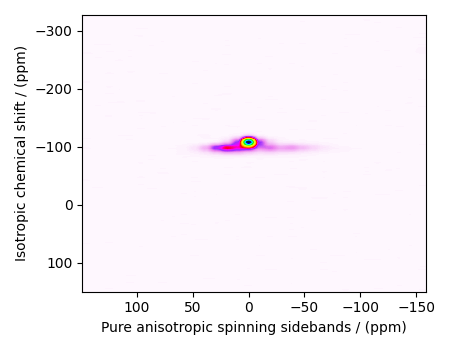
There are two dimensions in this dataset. The dimension at index 0 is the pure anisotropic spinning sideband dimension, while the dimension at index 1 is the isotropic chemical shift dimension.
Prepping the data for inversion¶
Step-1: Data Alignment
When using the csdm objects with the mrinversion package, the dimension at index
0 must be the dimension undergoing the linear inversion. In this example, we plan to
invert the pure anisotropic shielding line-shape. In the data_object, the
anisotropic dimension is already at index 0 and, therefore, no further action is
required.
Step-2: Optimization
Also notice, the signal from the 2D MAF dataset occupies a small fraction of the two-dimensional frequency grid. For optimum performance, truncate the dataset to the relevant region before proceeding. Use the appropriate array indexing/slicing to select the signal region.
data_object_truncated = data_object[:, 75:105]
plot2D(data_object_truncated)
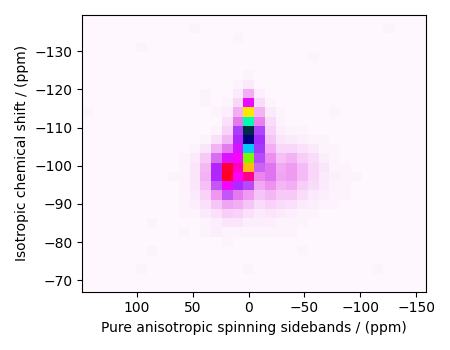
Linear Inversion setup¶
Dimension setup¶
Anisotropic-dimension:
The dimension of the dataset that holds the pure anisotropic frequency
contributions. In mrinversion, this must always be the dimension at index 0 of
the data object.
x-y dimensions: The two inverse dimensions corresponding to the x and y-axis of the x-y grid.
inverse_dimensions = [
cp.LinearDimension(count=25, increment="370 Hz", label="x"), # the `x`-dimension.
cp.LinearDimension(count=25, increment="370 Hz", label="y"), # the `y`-dimension.
]
Generating the kernel¶
For MAF/PASS datasets, the kernel corresponds to the pure nuclear shielding anisotropy
sideband spectra. Use the
ShieldingPALineshape class to generate a
shielding spinning sidebands kernel.
sidebands = ShieldingPALineshape(
anisotropic_dimension=anisotropic_dimension,
inverse_dimension=inverse_dimensions,
channel="29Si",
magnetic_flux_density="9.4 T",
rotor_angle="54.735°",
rotor_frequency="790 Hz",
number_of_sidebands=anisotropic_dimension.count,
)
Here, sidebands is an instance of the
ShieldingPALineshape class. The required
arguments of this class are the anisotropic_dimension, inverse_dimension, and
channel. We have already defined the first two arguments in the previous
sub-section. The value of the channel argument is the nucleus observed in the
MAT/PASS experiment. In this example, this value is ‘29Si’.
The remaining arguments, such as the magnetic_flux_density, rotor_angle,
and rotor_frequency, are set to match the conditions under which the 2D MAT/PASS
spectrum was acquired, which in this case corresponds to acquisition at
the magic-angle and spinning at a rotor frequency of 790 Hz in a 9.4 T magnetic
flux density.
The value of the rotor_frequency argument is the effective anisotropic modulation frequency. In a MAT measurement, the anisotropic modulation frequency is the same as the physical rotor frequency. For other measurements like the extended chemical shift modulation sequences (XCS) 2, or its variants, the effective anisotropic modulation frequency is lower than the physical rotor frequency and should be set appropriately.
The argument number_of_sidebands is the maximum number of computed sidebands in the kernel. For most two-dimensional isotropic v.s pure anisotropic spinning-sideband correlation measurements, the sampling along the sideband dimension is the rotor or the effective anisotropic modulation frequency. Therefore, the value of the number_of_sidebands argument is usually the number of points along the sideband dimension. In this example, this value is 32.
Once the ShieldingPALineshape instance is created, use the kernel() method to generate the spinning sideband lineshape kernel.
Out:
(32, 625)
The kernel K is a NumPy array of shape (32, 625), where the axes with 32 and
625 points are the spinning sidebands dimension and the features (x-y coordinates)
corresponding to the \(25\times 25\) x-y grid, respectively.
Data Compression¶
Data compression is optional but recommended. It may reduce the size of the inverse problem and, thus, further computation time.
new_system = TSVDCompression(K, data_object_truncated)
compressed_K = new_system.compressed_K
compressed_s = new_system.compressed_s
print(f"truncation_index = {new_system.truncation_index}")
Out:
compression factor = 1.032258064516129
truncation_index = 31
Solving the inverse problem¶
Smooth LASSO cross-validation¶
Solve the smooth-lasso problem. Use the statistical learning SmoothLassoCV
method to solve the inverse problem over a range of α and λ values and determine
the best nuclear shielding tensor parameter distribution for the given 2D MAT
dataset. Considering the limited build time for the documentation, we’ll perform
the cross-validation over a smaller \(5 \times 5\) x-y grid. You may
increase the grid resolution for your problem if desired.
# setup the pre-defined range of alpha and lambda values
lambdas = 10 ** (-5.4 - 1 * (np.arange(5) / 4))
alphas = 10 ** (-4.5 - 1.5 * (np.arange(5) / 4))
# setup the smooth lasso cross-validation class
s_lasso = SmoothLassoCV(
alphas=alphas, # A numpy array of alpha values.
lambdas=lambdas, # A numpy array of lambda values.
sigma=0.00070, # The standard deviation of noise from the MAT dataset.
folds=10, # The number of folds in n-folds cross-validation.
inverse_dimension=inverse_dimensions, # previously defined inverse dimensions.
verbose=1, # If non-zero, prints the progress as the computation proceeds.
max_iterations=20000, # The maximum number of allowed interations.
)
# run fit using the compressed kernel and compressed data.
s_lasso.fit(compressed_K, compressed_s)
Out:
[Parallel(n_jobs=-1)]: Using backend ThreadingBackend with 2 concurrent workers.
[Parallel(n_jobs=-1)]: Done 5 out of 5 | elapsed: 7.4s finished
[Parallel(n_jobs=-1)]: Using backend ThreadingBackend with 2 concurrent workers.
[Parallel(n_jobs=-1)]: Done 5 out of 5 | elapsed: 9.2s finished
[Parallel(n_jobs=-1)]: Using backend ThreadingBackend with 2 concurrent workers.
[Parallel(n_jobs=-1)]: Done 5 out of 5 | elapsed: 11.3s finished
[Parallel(n_jobs=-1)]: Using backend ThreadingBackend with 2 concurrent workers.
[Parallel(n_jobs=-1)]: Done 5 out of 5 | elapsed: 16.5s finished
[Parallel(n_jobs=-1)]: Using backend ThreadingBackend with 2 concurrent workers.
[Parallel(n_jobs=-1)]: Done 5 out of 5 | elapsed: 23.6s finished
The optimum hyper-parameters¶
Use the hyperparameters attribute of
the instance for the optimum hyper-parameters, \(\alpha\) and \(\lambda\),
determined from the cross-validation.
print(s_lasso.hyperparameters)
Out:
{'alpha': 5.623413251903491e-06, 'lambda': 2.2387211385683376e-06}
The cross-validation surface¶
Optionally, you may want to visualize the cross-validation error curve/surface. Use
the cross_validation_curve attribute
of the instance, as follows
CV_metric = s_lasso.cross_validation_curve # `CV_metric` is a CSDM object.
# plot of the cross validation surface
plt.figure(figsize=(5, 3.5))
ax = plt.subplot(projection="csdm")
ax.contour(np.log10(CV_metric), levels=25)
ax.scatter(
-np.log10(s_lasso.hyperparameters["alpha"]),
-np.log10(s_lasso.hyperparameters["lambda"]),
marker="x",
color="k",
)
plt.tight_layout(pad=0.5)
plt.show()

The optimum solution¶
The f attribute of the instance holds
the solution corresponding to the optimum hyper-parameters,
where f_sol is the optimum solution.
The fit residuals¶
To calculate the residuals between the data and predicted data(fit), use the
residuals() method, as follows,
residuals = s_lasso.residuals(K=K, s=data_object_truncated)
# residuals is a CSDM object.
# The plot of the residuals.
plot2D(residuals, vmax=data_object_truncated.max(), vmin=data_object_truncated.min())
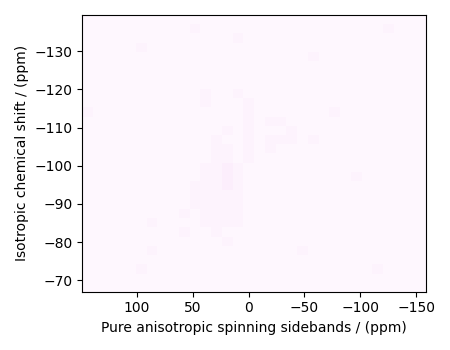
The standard deviation of the residuals is
Out:
<Quantity 0.00116292>
Saving the solution¶
To serialize the solution to a file, use the save() method of the CSDM object, for example,
f_sol.save("KMg_mixed_silicate_inverse.csdf") # save the solution
residuals.save("KMg_mixed_silicate_residue.csdf") # save the residuals
Data Visualization¶
At this point, we have solved the inverse problem and obtained an optimum distribution of the nuclear shielding tensor parameters from the 2D MAT dataset. You may use any data visualization and interpretation tool of choice for further analysis. In the following sections, we provide minimal visualization and analysis to complete the case study.
Visualizing the 3D solution¶
# Normalize the solution
f_sol /= f_sol.max()
# Convert the coordinates of the solution, `f_sol`, from Hz to ppm.
[item.to("ppm", "nmr_frequency_ratio") for item in f_sol.dimensions]
# The 3D plot of the solution
plt.figure(figsize=(5, 4.4))
ax = plt.subplot(projection="3d")
plot_3d(ax, f_sol, x_lim=[0, 120], y_lim=[0, 120], z_lim=[-50, -150])
plt.tight_layout()
plt.show()
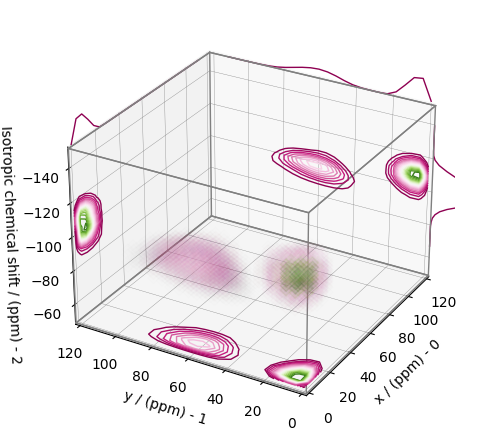
From the 3D plot, we observe two distinct regions: one for the \(\text{Q}^4\) sites and another for the \(\text{Q}^3\) sites. Select the respective regions by using the appropriate array indexing,
Q4_region = f_sol[0:8, 0:8, 5:25]
Q4_region.description = "Q4 region"
Q3_region = f_sol[0:8, 7:24, 7:25]
Q3_region.description = "Q3 region"
The plot of the respective regions is shown below.
# Calculate the normalization factor for the 2D contours and 1D projections from the
# original solution, `f_sol`. Use this normalization factor to scale the intensities
# from the sub-regions.
max_2d = [
f_sol.sum(axis=0).max().value,
f_sol.sum(axis=1).max().value,
f_sol.sum(axis=2).max().value,
]
max_1d = [
f_sol.sum(axis=(1, 2)).max().value,
f_sol.sum(axis=(0, 2)).max().value,
f_sol.sum(axis=(0, 1)).max().value,
]
plt.figure(figsize=(5, 4.4))
ax = plt.subplot(projection="3d")
# plot for the Q4 region
plot_3d(
ax,
Q4_region,
x_lim=[0, 120], # the x-limit
y_lim=[0, 120], # the y-limit
z_lim=[-50, -150], # the z-limit
max_2d=max_2d, # normalization factors for the 2D contours projections
max_1d=max_1d, # normalization factors for the 1D projections
cmap=cm.Reds_r, # colormap
box=True, # draw a box around the region
)
# plot for the Q3 region
plot_3d(
ax,
Q3_region,
x_lim=[0, 120], # the x-limit
y_lim=[0, 120], # the y-limit
z_lim=[-50, -150], # the z-limit
max_2d=max_2d, # normalization factors for the 2D contours projections
max_1d=max_1d, # normalization factors for the 1D projections
cmap=cm.Blues_r, # colormap
box=True, # draw a box around the region
)
ax.legend()
plt.tight_layout()
plt.show()
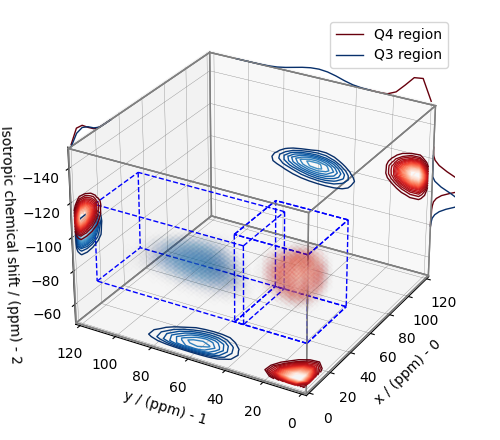
Visualizing the isotropic projections.¶
Because the \(\text{Q}^4\) and \(\text{Q}^3\) regions are fully resolved after the inversion, evaluating the contributions from these regions is trivial. For examples, the distribution of the isotropic chemical shifts for these regions are
# Isotropic chemical shift projection of the 2D MAT dataset.
data_iso = data_object_truncated.sum(axis=0)
data_iso /= data_iso.max() # normalize the projection
# Isotropic chemical shift projection of the tensor distribution dataset.
f_sol_iso = f_sol.sum(axis=(0, 1))
# Isotropic chemical shift projection of the tensor distribution for the Q4 region.
Q4_region_iso = Q4_region.sum(axis=(0, 1))
# Isotropic chemical shift projection of the tensor distribution for the Q3 region.
Q3_region_iso = Q3_region.sum(axis=(0, 1))
# Normalize the three projections.
f_sol_iso_max = f_sol_iso.max()
f_sol_iso /= f_sol_iso_max
Q4_region_iso /= f_sol_iso_max
Q3_region_iso /= f_sol_iso_max
# The plot of the different projections.
plt.figure(figsize=(5.5, 3.5))
ax = plt.subplot(projection="csdm")
ax.plot(f_sol_iso, "--k", label="tensor")
ax.plot(Q4_region_iso, "r", label="Q4")
ax.plot(Q3_region_iso, "b", label="Q3")
ax.plot(data_iso, "-k", label="MAF")
ax.plot(data_iso - f_sol_iso - 0.1, "gray", label="residuals")
ax.set_title("Isotropic projection")
ax.invert_xaxis()
plt.legend()
plt.tight_layout()
plt.show()
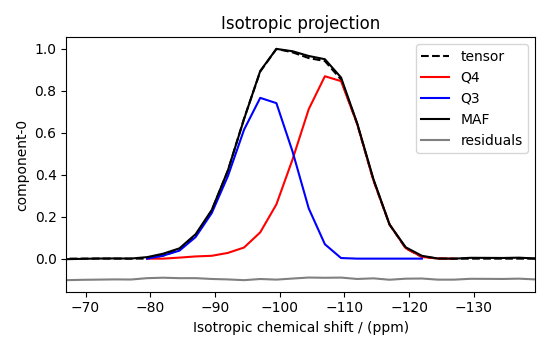
Notice the shape of the isotropic chemical shift distribution for the \(\text{Q}^4\) sites is skewed, which is expected.
Analysis¶
For the analysis, we use the statistics module of the csdmpy package. Following is the moment analysis of the 3D volumes for both the \(\text{Q}^4\) and \(\text{Q}^3\) regions up to the second moment.
int_Q4 = stats.integral(Q4_region) # volume of the Q4 distribution
mean_Q4 = stats.mean(Q4_region) # mean of the Q4 distribution
std_Q4 = stats.std(Q4_region) # standard deviation of the Q4 distribution
int_Q3 = stats.integral(Q3_region) # volume of the Q3 distribution
mean_Q3 = stats.mean(Q3_region) # mean of the Q3 distribution
std_Q3 = stats.std(Q3_region) # standard deviation of the Q3 distribution
print("Q4 statistics")
print(f"\tpopulation = {100 * int_Q4 / (int_Q4 + int_Q3)}%")
print("\tmean\n\t\tx:\t{0}\n\t\ty:\t{1}\n\t\tiso:\t{2}".format(*mean_Q4))
print("\tstandard deviation\n\t\tx:\t{0}\n\t\ty:\t{1}\n\t\tiso:\t{2}".format(*std_Q4))
print("Q3 statistics")
print(f"\tpopulation = {100 * int_Q3 / (int_Q4 + int_Q3)}%")
print("\tmean\n\t\tx:\t{0}\n\t\ty:\t{1}\n\t\tiso:\t{2}".format(*mean_Q3))
print("\tstandard deviation\n\t\tx:\t{0}\n\t\ty:\t{1}\n\t\tiso:\t{2}".format(*std_Q3))
Out:
Q4 statistics
population = 55.526682010553586%
mean
x: 8.668624339369668 ppm
y: 8.895729603986638 ppm
iso: -107.32386708833955 ppm
standard deviation
x: 4.73326212666404 ppm
y: 4.929006419658588 ppm
iso: 5.427012270570254 ppm
Q3 statistics
population = 44.47331798944642%
mean
x: 10.133763235406391 ppm
y: 62.26200849066072 ppm
iso: -97.01639426409565 ppm
standard deviation
x: 4.540084886749352 ppm
y: 10.65716485254756 ppm
iso: 4.741866191977004 ppm
The statistics shown above are according to the respective dimensions, that is, the
x, y, and the isotropic chemical shifts. To convert the x and y statistics
to commonly used \(\zeta\) and \(\eta\) statistics, use the
x_y_to_zeta_eta() function.
mean_ζη_Q3 = x_y_to_zeta_eta(*mean_Q3[0:2])
# error propagation for calculating the standard deviation
std_ζ = (std_Q3[0] * mean_Q3[0]) ** 2 + (std_Q3[1] * mean_Q3[1]) ** 2
std_ζ /= mean_Q3[0] ** 2 + mean_Q3[1] ** 2
std_ζ = np.sqrt(std_ζ)
std_η = (std_Q3[1] * mean_Q3[0]) ** 2 + (std_Q3[0] * mean_Q3[1]) ** 2
std_η /= (mean_Q3[0] ** 2 + mean_Q3[1] ** 2) ** 2
std_η = (4 / np.pi) * np.sqrt(std_η)
print("Q3 statistics")
print(f"\tpopulation = {100 * int_Q3 / (int_Q4 + int_Q3)}%")
print("\tmean\n\t\tζ:\t{0}\n\t\tη:\t{1}\n\t\tiso:\t{2}".format(*mean_ζη_Q3, mean_Q3[2]))
print(
"\tstandard deviation\n\t\tζ:\t{0}\n\t\tη:\t{1}\n\t\tiso:\t{2}".format(
std_ζ, std_η, std_Q3[2]
)
)
Out:
Q3 statistics
population = 44.47331798944642%
mean
ζ: 63.0813035582048 ppm
η: 0.20543107026990554
iso: -97.01639426409565 ppm
standard deviation
ζ: 10.544005747153385 ppm
η: 0.09682370563685412
iso: 4.741866191977004 ppm
Convert the 3D tensor distribution in Haeberlen parameters¶
You may re-bin the 3D tensor parameter distribution from a \(\rho(\delta_\text{iso}, x, y)\) distribution to \(\rho(\delta_\text{iso}, \zeta_\sigma, \eta_\sigma)\) distribution as follows.
# Create the zeta and eta dimensions,, as shown below.
zeta = cp.as_dimension(np.arange(40) * 4 - 40, unit="ppm", label="zeta")
eta = cp.as_dimension(np.arange(16) / 15, label="eta")
# Use the `to_Haeberlen_grid` function to convert the tensor parameter distribution.
fsol_Hae = to_Haeberlen_grid(f_sol, zeta, eta)
The 3D plot¶
plt.figure(figsize=(5, 4.4))
ax = plt.subplot(projection="3d")
plot_3d(ax, fsol_Hae, x_lim=[0, 1], y_lim=[-40, 120], z_lim=[-50, -150], alpha=0.4)
plt.tight_layout()
plt.show()
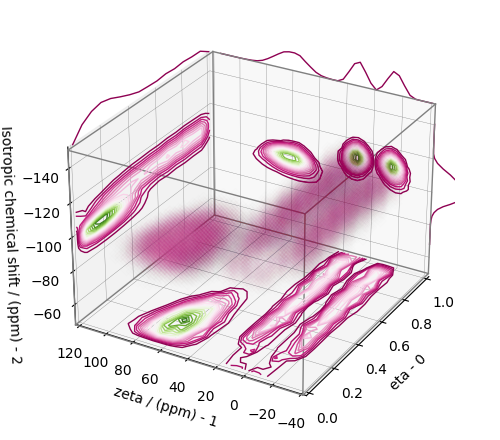
References¶
- 1
Walder, B. J., Dey, K. K., Kaseman, D. C., Baltisberger, J. H., Grandinetti, P. J. Sideband separation experiments in NMR with phase incremented echo train acquisition, J. Chem. Phys. 138, 4803142, (2013). doi:10.1063/1.4803142.
- 2
Gullion, T., Extended chemical-shift modulation, J. Mag. Res., 85, 3, (1989). 10.1016/0022-2364(89)90253-9
Total running time of the script: ( 1 minutes 20.095 seconds)
